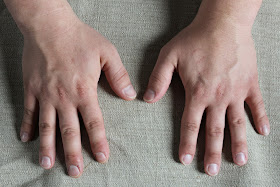I'm posting the photographs and notes below without much editing or commentary. I don't mean to fetishize craftspeople's hands. That's been done before and, I'll admit, sometimes with significant artistic accomplishment. In this case, I hope these photographs will be more intriguing and useful from a scholarly standpoint. I believe they may be of some interest to those seeking to understand historical labor, the history of the body, and the impact of a very specific type of physical activity on the human form. You can read more about the First Oval Office Project on this blog or the facebook page, and it almost goes without saying that our hands are not perfect doppelgangers of those of the tentmakers of 1777. After all, most of us grew up eating wholesome food and avoiding much manual labor. We generally enjoy a lifestyle that is remarkably kind to our hands compared to those of most past ages. But, at the very least, this data provides some hint of how hand-sewing affects the body and also of the many idiosyncrasies in technique that existed in our shop, as they certainly did in the shops of the Revolution.
Gwendolyn Basala (Right-Handed)
Gwendolyn has been sewing for over a decade, including professional work in theater and living history costuming. Although she developed calluses on her right hand in this previous, primarily machine-sewing work, it was only with this project that she noticed many pricks and minor calluses on her left hand, a result of regular contact with needle tips.
Mark Hutter (Right-Handed)
When Mark first started sewing years ago, he had carpal tunnel symptoms until he learned to relax the tension in his hands when sewing. Now, he notices a stronger pinch in his right thumb, index, and middle fingers than in his left. He has a permanent flat callus on the tip of his right index finger and a small ridge from writing and seating a thimble on his right middle finger. He keeps his thumb and index finger nails a bit longer for picking up pins and needles, and notices that when he's working regularly on a project, his nail growth speeds up significantly.
Brendan Menz (Left-Handed/Ambidextrous)
Brendan, who also works in leather and can sew with both hands, has calluses on his index and middle finger tips, as well as on the top tips of his thumbs. His index and middle fingers grew in thickness over the summer.
Joseph Privott (Left-Handed)
Joseph, who works in many media, noticed a few old calluses returning this summer, including one on the tip of his left index finger, from rubbing against the needle, and pricks on his right thumb and forefinger. Like most of the crew, he does not typically wear a thimble, resulting in a small gouged pocket in his left middle finger. On this particular day, his hands were somewhat stained from blackberries and featured traditional tattoos.
Tyler Putman (Right-Handed)
As for me, I noticed calluses developing on the thumb-side tips of my right index and middle fingers soon after the project began. Around the same time, I had some minor issues with wrist pain. You can see the distinctive green tarnish on my right middle finger from my brass thimble. Among other things, my right thumb and index finger are noticeably larger than those on my left hand, but it's hard to say whether this was a result of the sewing of this summer. I'll have to look closely in a year to see if they've atrophied at all.
Michael Ramsey (Right-Handed)
Michael has previous sewing experience and noticed calluses on right thumb tip and right forefinger tip. His right middle finger has less of a callus since he began using a thimble in mid-summer. Michael noticed minor wrist issues and his feet falling asleep after sitting cross-legged for too long. As can be seen in the last photograph, Michael's right index finger ended up substantially larger than his left.
Nicole Rudolph (Right-Handed)
A shoemaker and seamstress, Nicole has a slice on her right thumb from her cordwaining work. She noticed that the inside of her right middle finger went numb after using the large shears repeatedly. She has calluses on her right middle finger, on her left index and middle fingers from repeated pricking, and on her right pinky finger from pulling thread. She found that tentmaking required less strength than shoemaking, but also noticed that both her arms had grown larger over the past six months.
.JPG)
.JPG)
.JPG)

.JPG)
.JPG)
.JPG)
.JPG)
.JPG)
.JPG)

.JPG)
.JPG)
.JPG)
.JPG)

.JPG)
.JPG)
.JPG)
.JPG)
.JPG)

.JPG)
.JPG)
.JPG)


.JPG)
.JPG)
.JPG)
.JPG)
.JPG)
.JPG)

.JPG)
.JPG)

No comments:
Post a Comment